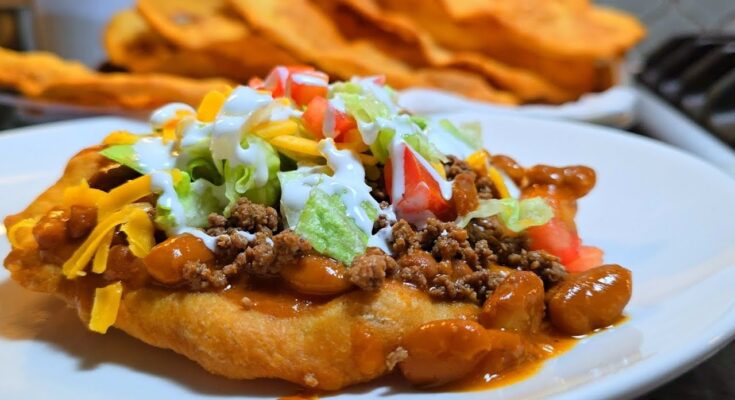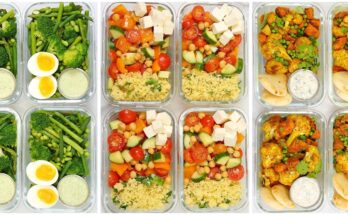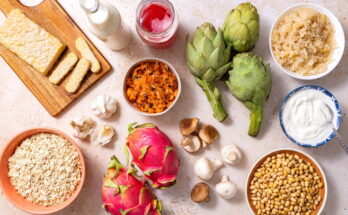Navajo Fry Bread Recipe: Navajo Fry Bread is a beloved traditional food rooted deeply in Native American culture, known for its crispy outside, fluffy inside, and golden-brown beauty. It’s a simple yet soul-satisfying bread made from pantry staples like flour, water, salt, and a leavening agent. Whether you’re savoring it as a base for savory taco toppings or enjoying it drizzled with honey, fry bread is comfort food at its finest.
The bread’s texture strikes a balance between soft and crispy — a delightful contrast that makes each bite irresistible. It’s often served hot, straight from the frying pan, creating a comforting aroma that instantly fills the kitchen. Many families have their own take on the recipe, passed down through generations, adding a personal touch that keeps this dish alive in Native traditions.
A Brief History and Cultural Significance
The story behind Navajo Fry Bread carries deep cultural and emotional meaning. It originated during the mid-1800s, when the Navajo people were forced to relocate along what is known as “The Long Walk.” Stripped of their traditional ingredients, they were given government rations like flour, lard, salt, and sugar — humble items that birthed what we now call fry bread.
Over the decades, it evolved into both a symbol of survival and a celebration of heritage. Today, it’s a staple at powwows, family gatherings, and Native festivals across the U.S. More than food, Navajo Fry Bread represents resilience, history, and unity — a recipe created from hardship that continues to bring joy to tables everywhere.
Ingredients You’ll Need
Basic Ingredients for Traditional Fry Bread
To make authentic Navajo Fry Bread, you’ll need only a handful of ingredients — most of which you likely already have in your kitchen:
Ingredients:
- 4 cups all-purpose flour
- 1 tablespoon baking powder
- 1 teaspoon salt
- 1 ½ cups warm water (add more if needed)
- 2 tablespoons vegetable oil (optional for softer texture)
- Oil for frying (vegetable, canola, or shortening)
Each ingredient plays a key role in creating the perfect texture. The flour forms the structure, baking powder gives rise and fluffiness, and salt enhances the flavor. Warm water helps activate the leavening, and oil prevents the dough from drying out too quickly. Choosing the right frying oil — one with a high smoke point — ensures an even, golden finish.
Optional Add-Ons and Variations
Want to give your fry bread a creative twist? Try these optional ingredients:
- Sugar (1 tbsp) for a slightly sweet bread.
- Milk instead of water for a richer, softer texture.
- Whole wheat flour for a denser, more nutritious version.
- Add cinnamon to the dough for a dessert-style base.
Experimentation is welcome here — many cooks add their own touches to reflect their personal or regional styles.
Ingredient Substitutions for Dietary Needs
If you’re catering to specific diets, here are some quick swaps:
- Gluten-Free: Use a gluten-free all-purpose blend.
- Vegan: The traditional recipe is already vegan-friendly, but avoid any dairy substitutes like milk unless plant-based.
- Low-Fat: Instead of deep-frying, use an air fryer or lightly pan-fry with minimal oil.
No matter the variation, the essence of Navajo Fry Bread remains the same — warm, simple, and made with care.
Kitchen Tools and Equipment
Essential Tools for Frying
Before diving into the dough, make sure your kitchen is ready with the essentials:
- Large mixing bowl
- Wooden spoon or spatula
- Rolling pin (optional — hands work fine too)
- Cast-iron skillet or deep frying pan
- Tongs or slotted spoon
- Paper towels (for draining excess oil)
- Cooking thermometer (for oil temperature control)
Having these tools on hand ensures your process goes smoothly and safely. Frying requires precision — too hot and the bread burns; too cool and it absorbs oil.
Recommended Alternatives if You Don’t Have Frying Tools
No cast-iron skillet? No problem. You can use:
- A heavy-bottom stainless-steel pan for even heat distribution.
- An air fryer for a healthier alternative (set to 375°F, cook until golden brown).
- A deep pot if you’re frying larger batches.
The key is maintaining consistent heat and ensuring your bread has enough room to puff up without sticking.
Step-by-Step Guide to Making Navajo Fry Bread
Step 1 – Preparing the Dough
In a large mixing bowl, combine the flour, baking powder, and salt. Gradually add warm water while stirring with a spoon or your hand. The dough should be soft but not sticky — similar to biscuit dough. If it’s too dry, add a tablespoon of water at a time until you reach the right consistency.
Once combined, drizzle in a bit of oil if desired, and lightly knead to form a smooth ball. The goal here isn’t heavy kneading — just enough to bring the dough together. Overworking it can make the bread tough instead of tender.
Step 2 – Kneading and Resting the Dough
Once the dough has come together, transfer it to a lightly floured surface. Gently knead it for about 5 to 7 minutes, just until it becomes smooth and elastic. You don’t want to overwork it — too much kneading will result in a dense, chewy texture instead of that soft, airy interior we’re aiming for.
After kneading, place the dough back into the bowl and cover it with a clean towel or plastic wrap. Let it rest for 30 minutes at room temperature. This resting period allows the gluten to relax, making the dough easier to shape later on. It also helps the baking powder activate fully, ensuring your fry bread puffs beautifully when it hits the oil.
If your kitchen is cool, you can let the dough rest a bit longer. The key is to achieve a soft, pliable texture — when you poke it with your finger, it should bounce back slightly. Once rested, divide the dough into equal portions (about 8–10 pieces depending on size preference). Each ball should be roughly the size of a tennis ball.
During this time, heat your frying oil in a deep pan over medium-high heat (around 350°F or 175°C). Maintaining the correct temperature is crucial. Too hot, and your bread will burn before it cooks through. Too cool, and it’ll absorb excess oil and become greasy.
Step 3 – Shaping the Fry Bread
Now comes the fun part — shaping your fry bread! Take one dough ball and place it on a lightly floured surface. Flatten it gently with your hands or a rolling pin until it forms a round disc about 6–8 inches in diameter and ¼-inch thick.
Traditionally, many cooks prefer stretching the dough by hand rather than rolling it, as this gives the bread a more rustic, authentic look. As you stretch it, try not to tear it. If it does tear slightly, that’s okay — it gives each piece its unique character.
Some like to make a small hole in the center of each disc to allow steam to escape and help it cook evenly. Others skip this step, resulting in a puffier bread. Both methods work — it’s all about preference.
To prevent sticking, dust each piece lightly with flour and place them on a plate or parchment paper. Keep them covered with a clean towel while you work through the rest of the dough so they don’t dry out.
Step 4 – Frying to Golden Perfection
When the oil has reached the right temperature, carefully slide one piece of dough into the pan. It should sizzle immediately — that’s how you know your oil is ready. Fry one piece at a time to avoid crowding, which can lower the oil temperature and make the bread greasy.
Let it cook for 1–2 minutes per side or until golden brown. Use tongs or a slotted spoon to flip it halfway through. You’ll notice the dough puffing up as it cooks, creating that signature light and airy texture.
Once both sides are beautifully golden, remove the fry bread and place it on paper towels to drain excess oil. Repeat with the remaining dough pieces, keeping them warm in a low oven (around 200°F or 95°C) until ready to serve.
The result? Golden, crispy edges with a soft, fluffy center that practically melts in your mouth. The aroma alone will have everyone gathering around the kitchen waiting for their turn!
Step 5 – Serving and Enjoying
Navajo Fry Bread is wonderfully versatile — it can be served in countless ways, from savory to sweet.
For a classic savory option, top your bread with seasoned ground beef, refried beans, shredded lettuce, diced tomatoes, cheese, and a dollop of sour cream to create a “Navajo Taco.” The combination of textures and flavors is absolutely irresistible — crisp, tender bread under rich, hearty toppings.
If you’re in the mood for something sweet, drizzle warm fry bread with honey, dust it with powdered sugar, or spread it with butter and cinnamon sugar. It’s like a dessert straight out of heaven — golden, slightly crisp, and melt-in-your-mouth tender.
Fry bread is best enjoyed fresh, straight from the pan, when it’s still warm and puffy. Pair it with a cup of coffee for breakfast or serve it as a base for dinner. Either way, this humble dish captures the heart and history of Native American culture in every bite.
Tips for Perfect Fry Bread Every Time
Common Mistakes to Avoid
Even though the recipe is simple, a few common mistakes can make or break your fry bread:
- Overkneading the dough: This can make it dense and tough. Handle it gently.
- Oil too hot: Bread will burn on the outside and stay raw inside.
- Oil too cool: Bread absorbs too much oil, becoming greasy.
- Too thick dough: It may not puff properly and could end up doughy.
- Skipping rest time: This prevents the dough from relaxing and puffing evenly.
To avoid these issues, focus on keeping the dough soft and light, the oil temperature consistent, and the cooking time short and even.
Expert Tricks for Fluffy, Crispy Results
- Use warm water (not hot) to activate the baking powder evenly.
- Add a tablespoon of oil or melted shortening to the dough for extra softness.
- For a lighter texture, let the dough rest for up to an hour instead of 30 minutes.
- Maintain oil at a steady 350°F — use a thermometer for accuracy.
- Flip only once during frying to avoid losing the puff.
These small steps can elevate your fry bread from good to perfect, giving it that restaurant-quality taste and texture every time.
Creative Ways to Serve Navajo Fry Bread
Savory Toppings (Taco Style)
Navajo Fry Bread isn’t just delicious on its own—it’s a perfect canvas for savory creations. The most popular variation is the Navajo Taco, which layers traditional taco ingredients atop freshly fried bread. Imagine a crispy-yet-fluffy base covered in seasoned ground beef, creamy refried beans, shredded lettuce, juicy tomatoes, and melted cheese. Finish it off with sour cream, sliced jalapeños, and a sprinkle of chopped cilantro, and you have a meal that’s both hearty and satisfying.
You can also customize your toppings depending on your taste. Try grilled chicken or shredded pork for a protein boost, or go vegetarian with black beans, corn, avocado, and salsa. The fry bread acts as a flavorful edible plate that holds everything together, soaking up juices and enhancing every bite.
For a more fusion twist, top your fry bread with pulled BBQ pork and coleslaw, or make a breakfast fry bread taco with scrambled eggs, bacon, and cheese. The possibilities are endless, and each variation pays tribute to the bread’s versatility. Whether served at festivals, family dinners, or backyard cookouts, fry bread tacos are always a crowd favorite.
Sweet Toppings for Dessert Lovers
If you have a sweet tooth, Navajo Fry Bread easily transforms into a delightful dessert. Right after frying, brush each piece lightly with melted butter and sprinkle generously with cinnamon sugar. The warmth of the bread melts the butter, creating a golden, crispy coating that’s pure indulgence.
Another popular variation is Honey Drizzle Fry Bread — simply pour warm honey over the bread and top with a dusting of powdered sugar. The contrast between the sweet syrup and salty, crispy bread is heavenly.
For a more decadent treat, go big with ice cream-topped fry bread. Add a scoop of vanilla ice cream, drizzle with chocolate or caramel sauce, and sprinkle chopped nuts or fruit for a dessert that rivals any funnel cake at a fairground.
Sweet versions of fry bread are especially popular during holidays and special gatherings. They offer that nostalgic, homemade comfort that reminds everyone of warmth, love, and family traditions.
Nutritional Information and Health Tips
Calorie Breakdown and Portion Control
Let’s face it — Navajo Fry Bread is a delicious indulgence, but it’s also fried, meaning it packs a calorie punch. A single serving (about 6 inches in diameter) can contain roughly 300–400 calories, depending on the oil used and whether you add toppings.
Here’s an approximate nutritional breakdown for one plain piece of fry bread:
| Nutrient | Amount (per piece) |
|---|---|
| Calories | 350 kcal |
| Total Fat | 15g |
| Saturated Fat | 2g |
| Carbohydrates | 45g |
| Protein | 6g |
| Sodium | 400mg |
| Fiber | 2g |
If you’re watching your intake, portion control is key. You can make smaller fry breads (around 4 inches) to enjoy the flavor without overdoing it. Also, balance your meal with lighter toppings like grilled veggies or lean proteins instead of heavy cheese and sour cream.
Making a Healthier Version
Craving fry bread but want a lighter alternative? You can make a healthier version by tweaking a few ingredients and methods:
- Air fry instead of deep fry: Lightly brush each dough piece with oil and air fry at 375°F until golden. This reduces fat content significantly.
- Use whole wheat flour: It adds fiber and nutrients, giving a nutty flavor while making it more filling.
- Opt for olive oil or avocado oil: These oils are heart-healthier options compared to shortening or lard.
- Bake instead of fry: Place flattened dough pieces on a baking sheet, brush with a touch of oil, and bake at 425°F for about 10 minutes, flipping halfway.
These small changes maintain the delicious essence of fry bread while making it more suitable for everyday enjoyment.
Storing and Reheating Fry Bread
How to Store Leftovers Properly
If you happen to have leftovers (which is rare because they disappear fast!), storing them correctly will keep them fresh for later. Allow the fry bread to cool completely before storing. Place pieces between layers of paper towels to absorb excess oil, then transfer them to an airtight container or resealable bag.
- At room temperature: Keeps well for up to 2 days.
- In the refrigerator: Lasts up to 5 days.
- In the freezer: Store in a freezer-safe bag for up to 3 months. Place parchment paper between each piece to prevent sticking.
Always make sure the bread has cooled fully before sealing to avoid trapping moisture, which can make it soggy.
The Best Methods for Reheating
To bring your fry bread back to life, skip the microwave — it can make it chewy and rubbery. Instead, try these methods:
- Oven: Preheat to 375°F and warm the bread for 5–7 minutes until crisp.
- Skillet: Heat on medium for 1–2 minutes per side to restore that golden crunch.
- Air fryer: Reheat at 350°F for 3–4 minutes — this works surprisingly well to regain the original texture.
Avoid reheating multiple times, as that can dry out the bread. Fry bread is always best enjoyed fresh, but with proper storage and reheating, it can still taste almost as good as day one.
FAQs about Navajo Fry Bread Recipe
1. Can I make Navajo fry bread without lard or shortening?
Absolutely! You can use vegetable oil, canola oil, or even avocado oil. The texture and taste remain wonderful without traditional fats.
2. Why is my fry bread hard or chewy?
That usually happens when the dough is over-kneaded or the oil is too cold. Keep the dough soft and handle it gently, and ensure your oil stays around 350°F.
3. Can I bake instead of fry Navajo bread?
Yes! Baking at 425°F for about 10 minutes creates a lighter version. It won’t have the same crispiness, but it’s a healthier alternative.
4. What oil is best for frying?
Neutral oils like vegetable, canola, or sunflower oil are best. They have a high smoke point and won’t alter the flavor of the bread.
5. How long does fry bread stay fresh?
At room temperature, it stays fresh for 1–2 days. For longer storage, refrigerate or freeze it as described above.
Conclusion
Navajo Fry Bread is more than just a recipe — it’s a story of resilience, creativity, and community. Born from necessity, it evolved into a cherished dish that unites generations and cultures. With its crispy golden edges and tender center, this simple bread continues to capture hearts and appetites everywhere.
Whether you enjoy it as a savory Navajo taco, drizzled with honey for dessert, or straight from the pan with a sprinkle of salt, each bite carries warmth and history. And the beauty of it all? Anyone can make it with a few basic ingredients and a little patience.
So next time you’re craving something special, skip the fancy recipes — reach for flour, water, and love, and create a piece of tradition right in your kitchen.



